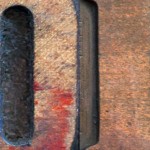This is one article to which many people will reply, “Who cares?” So let’s begin by reviewing the name of this site—”Overthinking Design.” Admittedly, this is a small issue that I’ve put too much thought into. But with design the details matter, and text formatting is often overlooked. So buckle yourself in as we take a close look at…phone numbers!
When it comes to designing text there are two main goals. Above all, you want the text to be understood and processed quickly. Second, you want the text to be attractive or, at the very least, appropriate. This applies to headings, it applies to body text, and it even applies to “scraps” of text—like phone numbers.
Over the past decade, it has become very popular to separate phone number segments with periods. You’ve seen it done. You’ve probably done it. I’ve certainly done it. The question I’m asking is whether we should use periods to segment phone numbers.
Let’s start by dissecting the anatomy of a phone number. In the United States we use three segments which follow the 3-3-4 format. We’re all familiar with the three-digit area code. This is followed by a three-digit exchange. And bringing up the rear is a four-digit subscriber number (or line number). When you dial outside of the United States you have country codes to include, plus many European countries use variable length numbers. But we’re going to look only at the United States format.
The traditional formatting of a phone number includes parentheses around the area code, and a dash between the exchange and the subscriber number. As design is largely about simplification, the dotted phone number does make sense. The traditional format includes 14 characters if you count spaces. The dotted phone number reduces that to 12. Also, there’s less clutter. Let’s face it—parentheses are clunky, as their vertical height is significantly larger than that of the numbers they contain. Now, some fonts do contain numbers with exaggerated ascenders and descenders, but for the majority of fonts period-based phone numbers allow for a consistent height across the board.
These issues of simplification make it difficult for me to say much against using periods in phone numbers. However I do have a couple points of caution.
The first is that over-simplification can lead to sterility. Your basic dotted phone number has little character. Yes, on your fancy concert poster you can spice things up. But let’s consider a less romantic scenario—the footer of a web page using the basic Arial font. On technology-based websites, I feel the dotted phone number works great. It fits the feel. It’s modern and it’s sleek, especially compared to the traditional format. But on Mom & Pop’s simple “buy my handmade product” site, a dotted phone number feels out of place. There are times traditional works and feels so much better.
The other issue is readability. The reality of the situation is that simplification does not necessarily increases readability. It can make things unique, attention-getting, and clean, but that does not equal readable. The parentheses and dash are used for a reason. They visually separate the segments of a phone number, making it easier to digest and easier to remember. We mentioned that the periods save space. But it can be argued they save too much space. The horizontal distance periods takes up is less than that of a dash or even a space. The segments of the phone number are now very close together. It’s clean, but it’s less readable.
My encouragement is to simply consider the setting. This is not a matter of right and wrong, but of appropriateness. People will be able to read the phone number regardless, so with this issue it’s absolutely fine to choose an option that may be slightly less readable in order to create a more appropriate feel. But your reason for using the periods should go beyond the fact that it’s a trending practice.
Let’s consider this matter completely overthought.




One other thought. Usability. For digital design, mobility matters. In the mobile space, xxx.xxx.xxxx doesn’t automatically hyperlink to a mobile phone’s dialer, while xxx-xxx-xxxx can.
Excellent point. Thanks, Brian!
Actually phones will link . or – between phone number as well as (###)###-#### so although I hate the period format, that point is actually moot.
This has been fixed. All style varieties for writing phone numbers now seem to auto-correct and automatically work as hyperlinks for the receiver.
I just tested for Android mobile and iPhone and these all work: ###-###-####, (###) ###-####, ###.###.####
Virtually universally, clarity in communication should trump being different. Phone numbers with dashes were distinctive from dates and money numbers, now they all look nearly alike as people write to be different, 912.201.4121 or $912,201,412 or 9.12.2014. A glance will certainly not be enough any more. I think phone numbers with dots is the triumph of stupidity over clarity.
I’m with you, Sally. Thanks for posting. You’re absolutely right… they all start looking alike.
This is one of my little pet peeves as an editor. I can’t stand it when someone submits something with periods in a phone number. I’ve never understood it.
If you are using Google voice (or Gchat or Gmail) – it will recognize the XXX.XXX.XXXX syntax. I received a Gmail message with a phone number (having the period syntax) and I clicked on it and it placed the call.
=)
I use periods in phone numbers for the simplicity of doing artwork for tee shirt designs for screen printing. The normal dashes are always off centered from top to bottom and look weird in using different fonts. If it is a simple font I will use a dash but I like using the periods. Centers everything up nicer in my opinion. I’ve never put much thought into it until today. I have been doing designs for 16 years and always just go with my gut on what I think looks nice. My coworker/brother pointed it out today and said why are you using periods…what are you trying to reinvent the way we write phone numbers, lol. I guess I did not know that people didn’t like it until now. I may try to use the dash more from here on out.
Thanks for the comment Roger. And the point of this post isn’t to say that you shouldn’t use periods. It depends on the application and (you make a good point) it depends on the font as well. It’s more to say, don’t use periods blindly without considering whether they’re the best choice.
In design I agree this can look appealing in places. Flyers, catalogs and occasionally websites.. But I deal with software and data. This makes things a nightmare.. Sales reps, CFO’s etc see good looking phone numbers using periods on there business cards, websites, brochures and email signatures… Then out of habit start using that format when entering information into ERP or CRM or just about anything else and it’s a disaster when it’s time to export, import or create custom reporting or anything that reads phone numbers.
I agree…Cheers!, well said.
As an ex-techie … the dotted.notation.looks.like-an-Internet-Protocol-address | Keep the dash as it informs you (or the machine) that it is a phone number.
I don’t understand why you’ve reduced the choice to “(123) 456-7890” or “123.456.7890”. Neither is the most widely used standard, which is “123-456-7890” (this is the AP style guide standard, Chicago Manual of Style, etc.). This solves your excess character problem and height problem of parentheses without trying to create a new standard. (Using parentheses is the next most common standard, but I would argue outdated in the era of cell phones and numbers that persist through geographic moves – most of us dial the area code for every call now.)
Great point and thanks for the comment. This post is written from a very nitpicky visual design standpoint. Even if it’s not the most common format (or the approved standard), I much prefer the use of parentheses over two dashes as the parentheses and dash do a better job of visually separating the segments of the phone number.
10-digit dialing became standard in about 1998. People keep their phone numbers for life now — who relocates to a new city and changes their number? Just the dashes, please. 123-555-4567.
Cheers!
Here here!
Charond, the reason people put dots in between phone numbers might be due to a person’s profession; people who work with numbers all day, some say, like dots instead of negatives, especially in accounting j/k
(309) 567-6284
309.567.6284
The decimals make it run together. The parentheses and hyphens make it easier to read. Whose bright idea where these decimals anyway!!!!
Some advertiser thought it would be “keuwl” to make a phone number look like a web address. Then it caught on. The same thing happened with writing things vertically, but the wrong way around. It was for an advertisement to catch attention. People, or should I say sheeple, often latch on to the wrong way of doing things because it caught their attention. There is a proper format for information and a phone number has a long-established format. I punch in phone numbers on my phone and it cannot use the periods as separators. So I punch it in as a web address, and it invariably fails. Stop being “trendy” and just do things properly please. Otherwise, you’re just being annoying. We’ve got better things to do than to convert a phone number to letters. That too is a recent trend and it takes longer to dial. Just stop it, please.
In an international and connected world you should always prefix your number with the country code, starting with a + sign. The + means add the local international dialing prefix, which is country specific. So for a USA number: +1-912-201-4121 . If phone numbers are stored in your mobile phone contacts list in this format, then you should be able to dial USA numbers from any overseas country (subject to roaming agreements and costs etc). The local system will use the appropriate international dialing prefix instead of +.
A graphics designer said the number with dashes designates a phone number while a number with periods designates a fax number.
Thanks for the comment, James. Interesting concept, but I don’t think that’s the case. I’ve never seen one format used for a phone number and another for fax.
Foe graphics try dots to separate phone numbers: 800•123•4567
I use periods as it faster. The period is on the keyboard and numbers at top of keyboard. To get to “(” and “)” or “-” you have to select the symbol section to pop up. Assuming your on a smart device ie. Phone vs. Computer keyboard.
Yeah, that’s understandable for day to day communications. And while the thoughts in this article can still apply to emails and texts, the focus is on graphic design applications. Thanks for the comment!
A period has a special significance when used with numerals. (That’s why it’s on your number pad.) We had a problem when a phone list was moved from a text file, to a spreadsheet, to a PDF. The spreadsheet rounded the phone numbers, so 123.4567 became 123.46.
I first used this in 2003 while doing a floor care carton box design for a major brand. I was usually constricted by graphic standards manuals for our other brands that I sort of got cute with the freedom I had on this particular label.
It’s a lot more prevalent now and honestly I don’t use it as much anymore (in part due to URLs) unless its graphically pleasing.
I’ll add, I always added spaces before and after the periods for reliability.
Personally I consider parenthesis to be the “official formatting” as it is what is used by the telephone company, and recommended by the AP style guide. As such I am a total stickler for making sure that this format is observed on all web and printed materials.
Actually I just found out the AP changed their style for phone numbers in 2006. But I still dont care. As far as I am concerned parenthesis is the correct formatting.
I can live without the parentheses and vote for using En dashes between the numbers—it spaces them out better and is easier to read quickly, periods leave the numbers too close together. I work with one European doctor who runs all the numbers together—I have to read the number beforehand and put lines between!!!
Hi, what’s your opinion about a contact phone number in a brochure?
It depends on so many factors. If it’s a single phone number, the period format isn’t a huge deal (especially if it’s a more modern design). If it’s multiple phone numbers, I like the parentheses method. I prefer the using parentheses regardless, but to each their own!
Especially for a business. 10 digits, no parentheses.
…Didn’t someone mention the AP stylebook above??
Good points. Especially after looking at all the comments, it seems that the phone number is a strong enough convention that it is reliably recognizable in a number of various treatments. This gives the designer some latitude, to choose punctuation along with font, color, and other visual styles to best fit the circumstance and intention of the work. Once again, the correct answer might be “it depends”.
I’m retired IT. Putting periods in a phone number will make it an IP address.
The use of hyphens in formatting North American telephone numbers is a telecommunications industry standard (North American Numbering Plan). See https://nationalnanpa.com/about_us/abt_nanp.html
Good editors use standard forms for units of measurement. There is no reason to behave differently with telephone numbers.
It is my understanding that parentheses indicate when an area code may not be needed and all hyphens are used for numbers where you typically need to dial the whole thing. I live in a state with a single area code and it is not necessary to dial it: (207) xxx-xxxx rather than 207-xxx-xxxx. Either way I think that hyphens are much more easily read than periods. However, the university where I work has established periods as our standard.
I’ve been thinking about this. Much easier to use 000.000.0000 As a copywriter and product namer, I like to use fewer and few keystrokes. Love to share! Who is the author? Background?
1) In a large survey a few years ago, people said that using dots in phone numbers comes off as “pretentious” and looks “wrong”.
2) Internet IP addresses are expressed in a dotted format that is derived from Abstract Synatx Notation (ASN). Phone numbers with dots are, to old time professional programmers, simply wrong – because the notation is being mis-used.
3) Tests have shown that dotted phone numbers are mis-dialed more than the old (xxx) yyy-zzzz format. Also, harder to remember.
I’m with Christopher. It seems like the dots are an imitation of IP addresses, i.e. pretentious. I think (en) dashes are best.
You all can blame me for the transition from dashes to periods.
I started using periods 20 years ago for anything with a phone number.
Periods in phone numbers looks cleaner and makes it more compact.
I hate dashes in anything. They’re like using underscore when naming files. Completely pointless.
Periods = laziness. Pure and simple. You are also as Gina points out making your number a huge PITA for someone who needs to use it for data entry etc. They now have to retype it adding the dashes in between. It drives me bonkers having to fix that on a regular basis. Stop be so lazy.
It’s the same people that wouldn’t press the shift key if their life depended on it. Lazy! And so little time savings